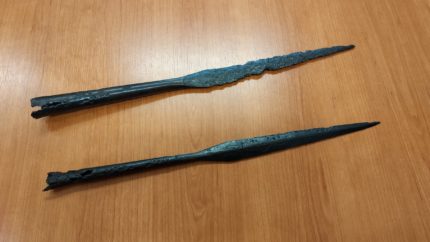A medieval cemetery of the Yotvingian people replete with weapons has been discovered near the city of Suwałki in northeastern Poland. It dates to between the 11th and 13th centuries and is a rare layered cremation cemetery featuring the remains of collective funerary pyres with large numbers of grave goods, likely added to the pyre late so they would not be destroyed by the fire.
The Yotvingians (also known as Sudovians) were a Baltic tribe who lived in parts of what are now Poland, Lithuania and Belarus from the 5th century B.C. to the Middle Ages and beyond. They were known for their skill in battle, feared as raiders and alternately serving as mercenaries for princes of the Kievan Rus and being conquered by them. They also clashed with Polish princes and the Teutonic Knights. In 1422, Yotvingia was conquered by the Teutonic Order and its territories partitioned between the Knights, Poland and Lithuania, but elements of Yotvingian ethnicity, language and culture persisted through the 19th century.
A Yotvingian barrow cemetery in use between 2nd and 5th centuries A.D. was discovered in the suburbs of Suwałki in the 1950s. It was very rich in grave goods, many of them weapons. The newly discovered cemetery is at least as significant in terms of recovered archaeological artifacts and is the largest known Yotvingian cemetery from the early Middle Ages. So far only 1,000 square feet have been excavated of the half hectare (ca. 54,000 square feet) site, and the team has found more than 500 important objects — swords, knives, arrowheads, spurs, buckles, horse fittings — and several thousand smaller artifacts.
With the remains found just 8 to 12 inches below the surface, layered cemeteries from this period are often destroyed by agricultural work, making this discovery exceptional. Unfortunately, looters found it first. The signs of illegal excavation are what alerted authorities to the site. The subsequent investigation found evidence that around 1,000 artifacts were stolen before the area was secured.
The artifacts will be studied and conserved at the Regional Museum in Suwałki and a selection of them are planned to go on display at a new exhibition in late May.

